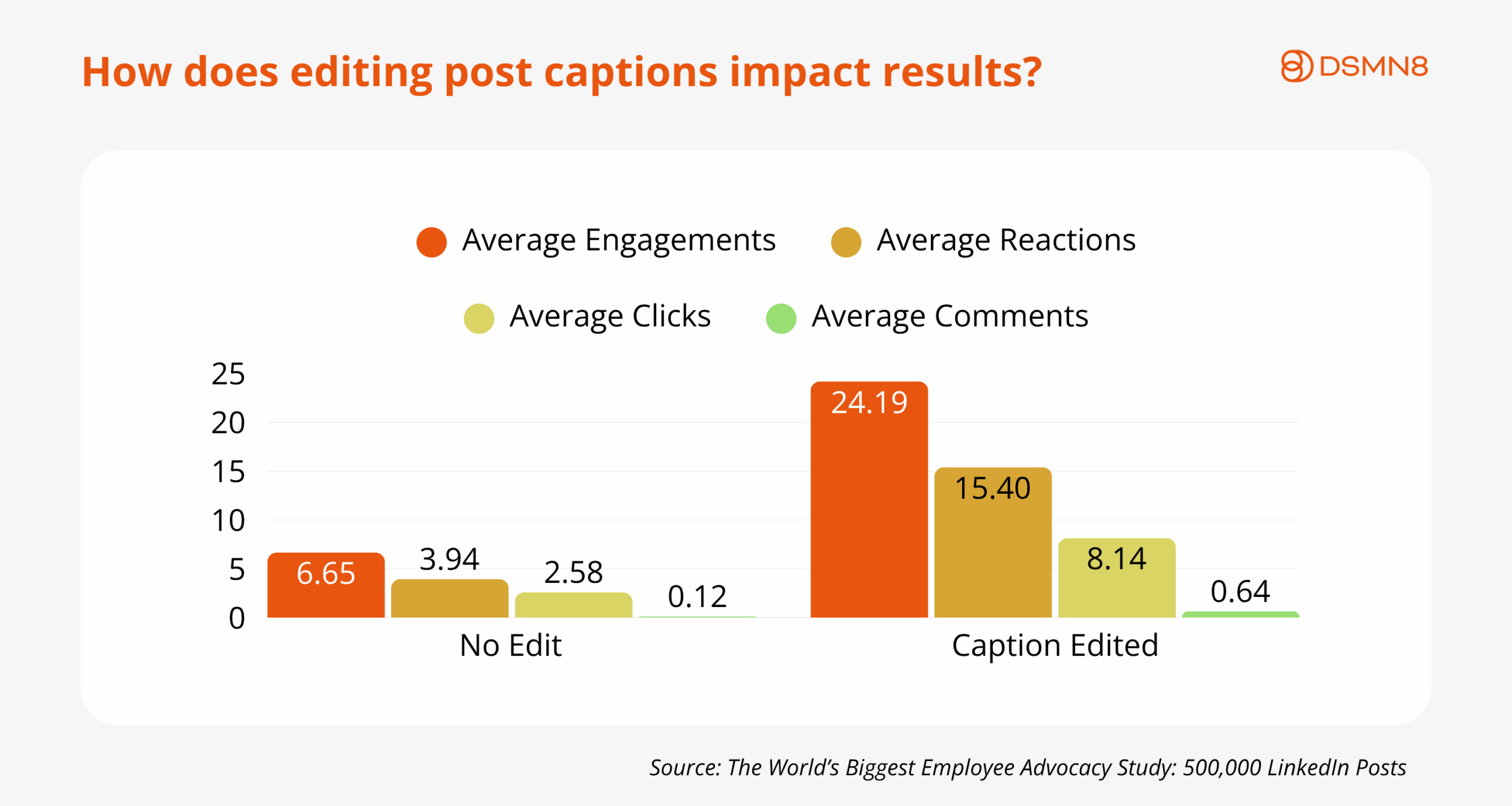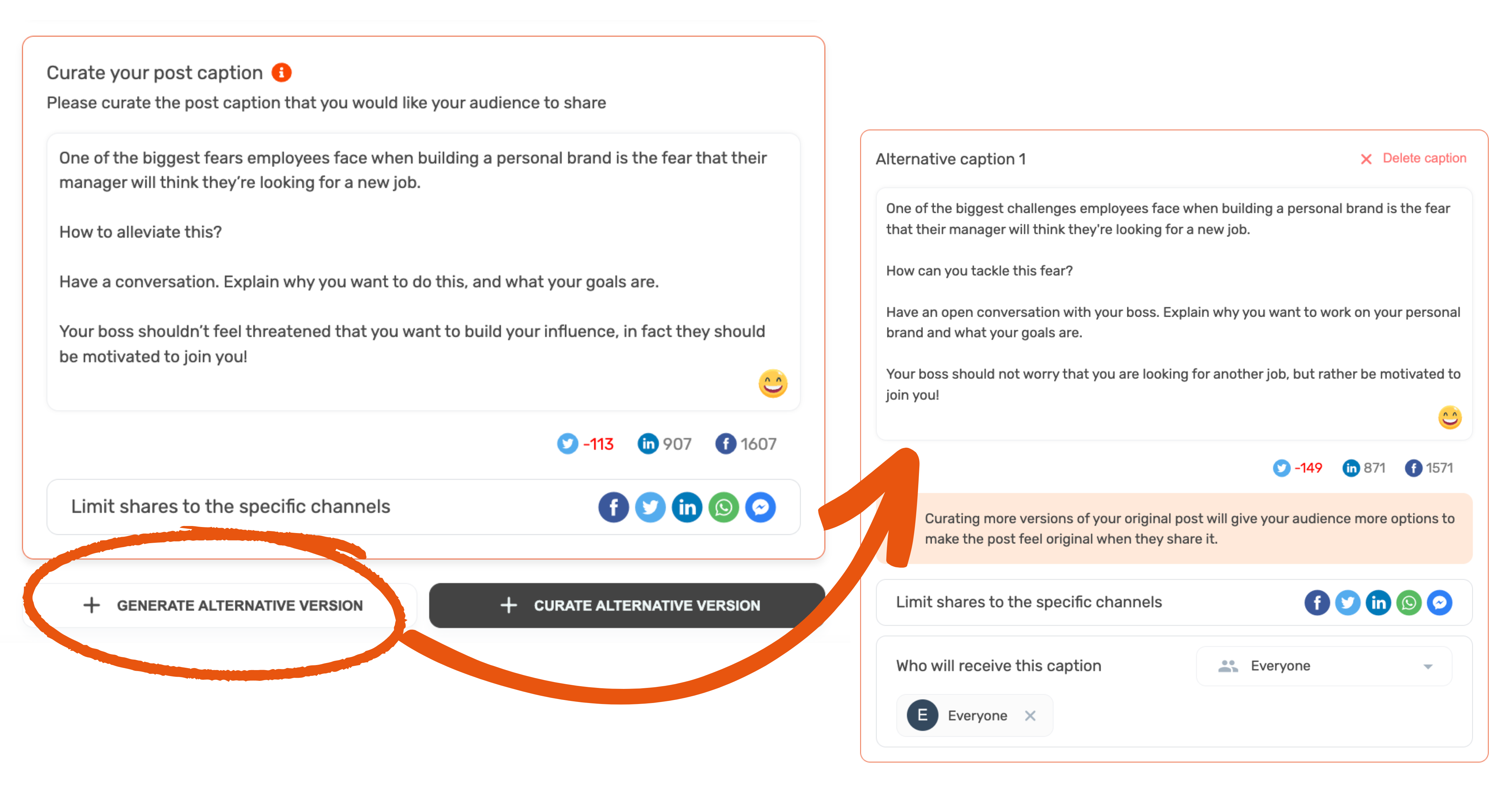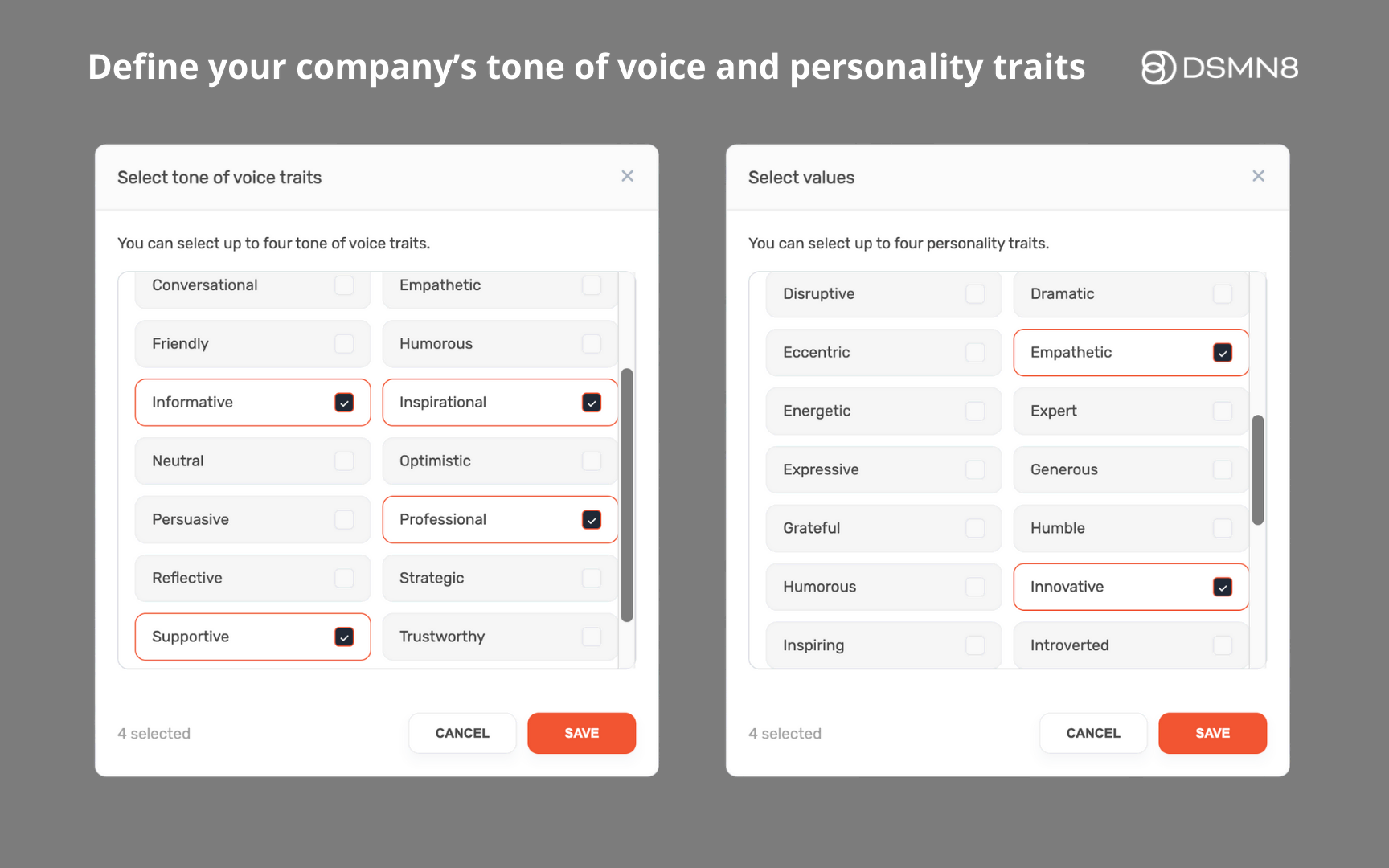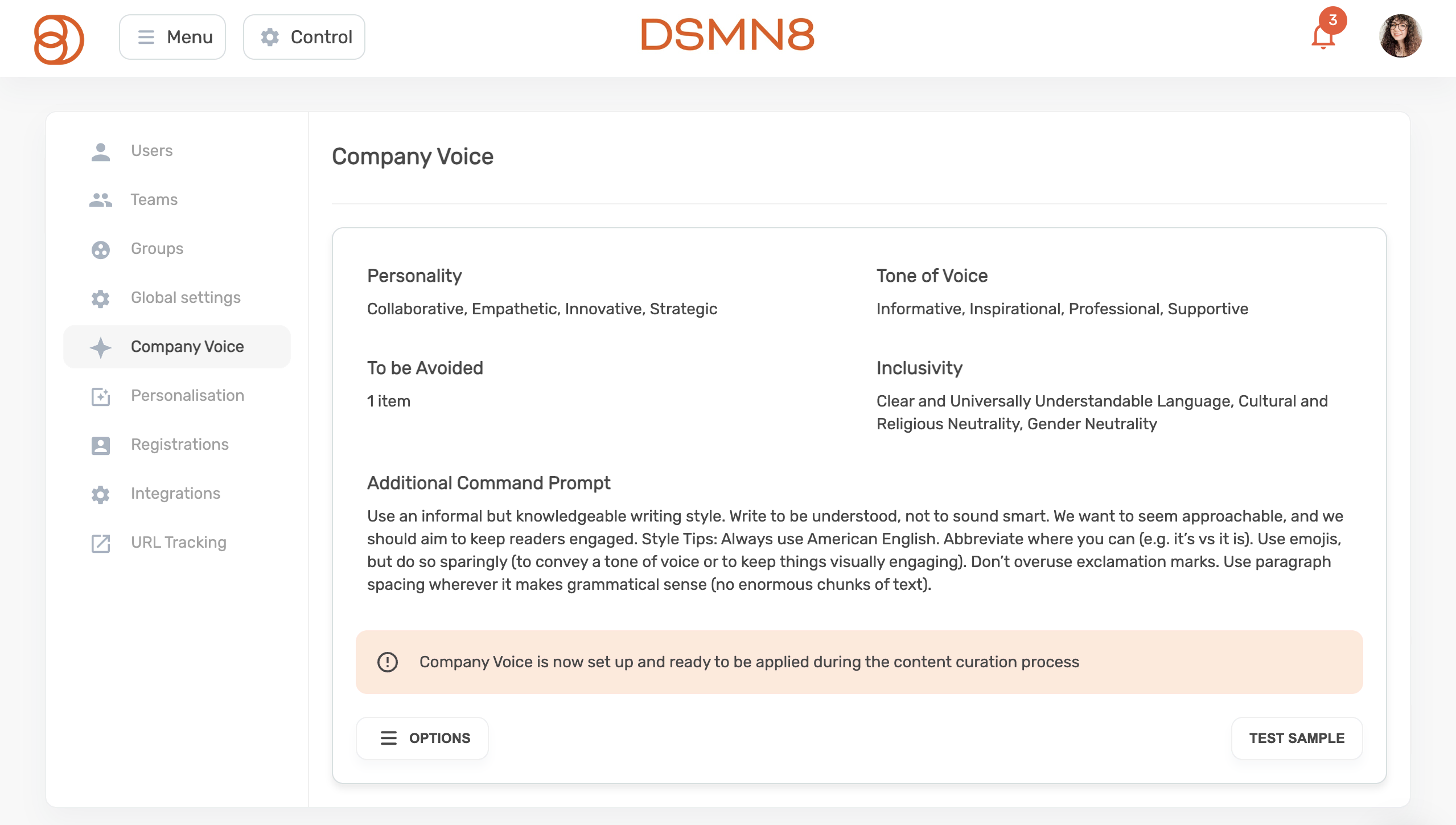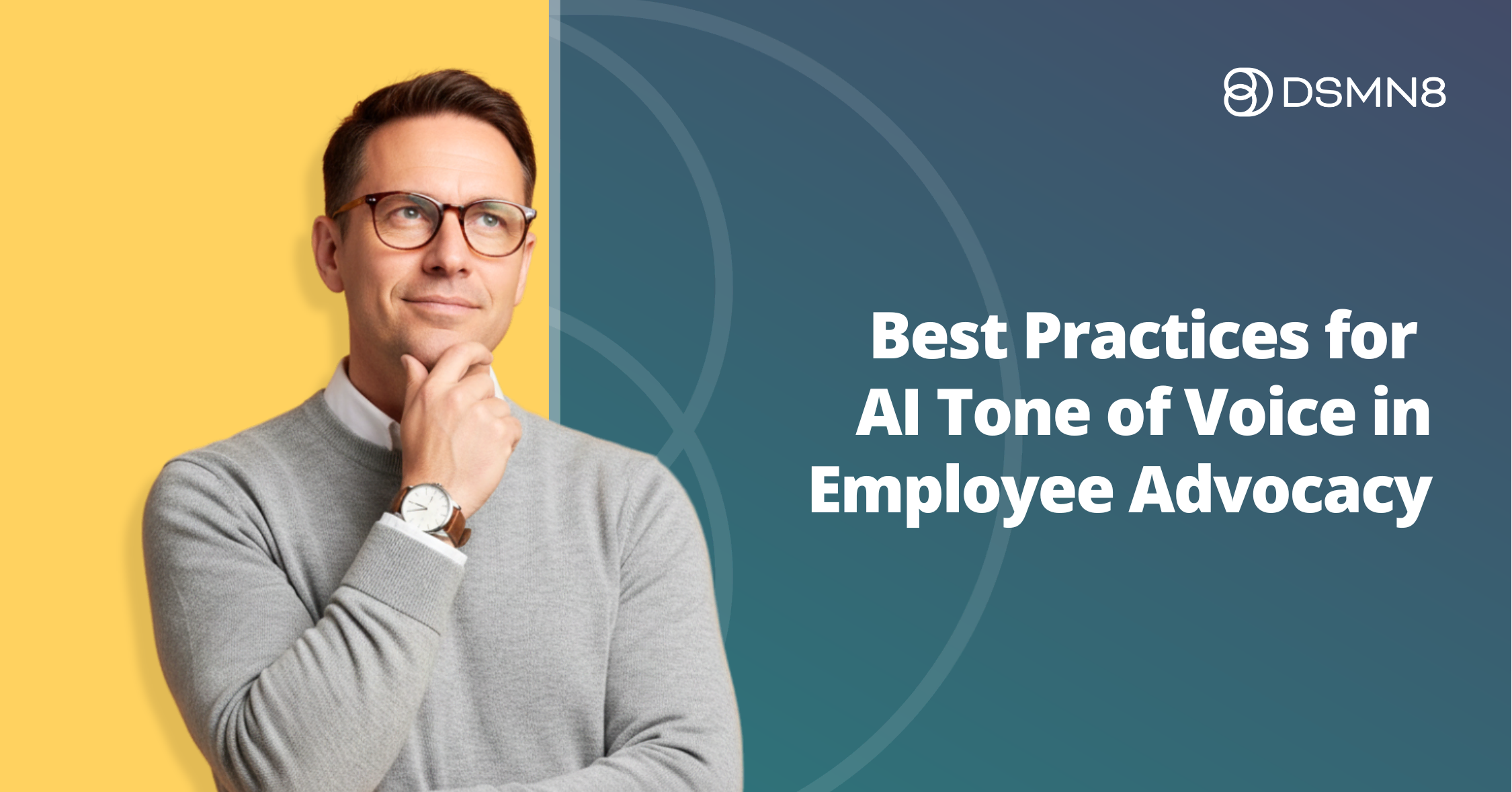
In employee advocacy, the gap between an average post and one that sparks engagement often comes down to tone of voice.
The World’s Biggest Employee Advocacy Study revealed that even the smallest caption edit (just a 1% change from the original) can triple engagement. In other words, it’s not just about what employees share, but how they say it.
AI can help scale advocacy content creation, but without clear guidance, it risks producing posts that feel generic or overly corporate.
That’s why DSMN8 created Company Voice: a way to set tone-of-voice preferences and guidelines for AI-generated captions.
Company Voice is your brand-safety net at scale. It’s the guardrail that ensures AI-generated captions stay authentic, compliant, and on-message, no matter who’s posting.
Today, we’ll be sharing best practices for setting up the tool. Not yet using DSMN8? Don’t worry, we’ve included tips for using tools like ChatGPT as well.
Why Use AI for Employee Advocacy Content?
AI is incredibly helpful for scaling employee advocacy program content and reducing the burden on busy employees.
With the right setup, it removes friction and gets more people posting more often.
But here’s the catch: audiences are quick to spot “AI tells.”
Posts that sound over-engineered or generic risk losing trust instead of building it.
The Role of Human Editing
That’s why AI should never be a copy-and-paste exercise.
The best results come when AI-generated text is:
-
Edited by employees to reflect their own tone of voice for authenticity. Your team should add their own insights and experiences where possible.
-
Guided by clear instructions to avoid common pitfalls like overly formal language and excessive punctuation (hello em dash 👀).
-
Directed by brand guidelines, especially in regulated industries. If inclusive language is important to your company or you need to use British English, make sure your AI tool is aware!
Common “AI Tells” to Avoid
When reviewing drafts, encourage employees to cut or replace phrases that signal “AI wrote this”.
You can, of course, instruct AI to avoid these, but it’s best practice to ask your content curators and employees to look out for them:
-
Formulaic sentence structures: “It’s not just X, it’s Y.”
-
Overly formal vocabulary: words like “delve,” “plethora,” or “pioneering.”
-
Excessive punctuation and emojis: em dashes and rocket emojis galore.
-
Cliche phrases: “In today’s digital landscape…” 🥱
By pairing AI with employee input, you get the best of both worlds: scale and efficiency plus authentic, trustworthy voices that resonate with audiences.
Company Voice: Your Compliance Safety Net at Scale
Company Voice allows program admins to set tone-of-voice preferences for our AI Content Assistant.
If you’re not already familiar with the feature, here’s a brief explainer:
DSMN8’s AI Content Assistant enables content curators to generate multiple variations of a LinkedIn caption based on a provided post.
This makes it easy to ensure that your advocates aren’t all sharing identical posts, while significantly reducing the time needed for content curation.
While other platforms leave you to hack together AI prompts, DSMN8’s Company Voice standardizes tone of voice and brand safety.
But it’s not just about consistency with your brand guidelines.
Without clear guardrails, AI-generated posts risk non-compliance, particularly in regulated industries.
Company Voice eliminates that risk, allowing you to control and standardise AI use across your employee advocacy program.
| Without Company Voice | With Company Voice |
|---|---|
| AI captions risk going off-brand. | Standardised brand safety across every caption. |
| Employees copy-paste prompts inconsistently. | Consistent tone, inclusivity, and compliance. |
| Compliance concerns stall adoption. | Guardrails that give employees confidence to share. |
5 Best Practices for Tailoring AI Company Voice
Once defined by a program admin, all content curators will be able to use Company Voice when generating captions.
If you don’t get it right the first time, don’t worry – it can be tweaked at any time.
That said, here are some best practices we’ve found from testing the tool ourselves and with our clients:
1: Share content examples.
Feed in examples of posts that represent your employee advocacy content and brand at its best. AI learns more from concrete samples than abstract descriptions.
2: Tweak personality & tone of voice traits.
When sharing content samples, DSMN8 will automatically select the personality and tone of voice traits that match the content provided.
You can manually edit these if you believe other traits better reflect your brand.
3: Specify inclusivity requirements.
Specify things like gender-neutral phrasing, cultural and religious neutrality, or avoiding curse words, so posts reflect your company’s values.
You can even instruct it to prevent mentioning any of your competitors if you wish.
4: Use additional command prompts for further rules and content styling.
Add extra instructions, e.g., “keep under 500 characters” or “include a light call-to-action” to refine outputs further.
We like to include line breaks and paragraph spacing because no one wants to read a huge block of text on LinkedIn!
5: Run test samples.
This is the most important part: test and test again. Generate a few draft captions and review the output.
Does the content sound like your employees would share it? Would you feel confident posting it on your own LinkedIn? Adjust until it feels right.
💡 Top Tip: If you’ve already nailed your AI tone of voice from using tools like ChatGPT, you can apply this in DSMN8 rather than using the Company Voice wizard. Head to ‘Convert to Prompt’ to do this. We only recommend this to those who are experienced in AI prompting.
Once your Company Voice is set up, it can be applied to any captions during the curation process as shown above.
You can also save custom AI prompts for any additional tweaks you’d like to make.
For example, you might want to create an emoji-free caption in an authoritative tone of voice for your engineers, or create shorter captions suitable for sharing on X.
Not using DSMN8 yet? Try This
If you’re not using DSMN8 to manage your employee advocacy program, you can still apply these best practices when prompting AI tools like ChatGPT.
Simply follow the same approach, keep testing and tweaking the prompt until you’re happy with it, then share it with your content curators to use.
Additional Resources
AI makes it easier than ever to scale employee advocacy.
But scale alone isn’t enough.
Employee advocacy content needs to sound authentic and follow your brand guidelines.
Company Voice doesn’t simply generate captions. It standardises trust.
While others hack together prompts and hope for the best, DSMN8 makes brand safety and authenticity scalable.
Watch DSMN8 turn AI-generated captions into brand-safe, authentic advocacy posts in seconds.
More on Using AI with Employee Advocacy:
Emily Neal
SEO and Content Specialist at DSMN8. Emily has 10 years experience blogging, and is a pro at Pinterest Marketing, reaching 1 million monthly views. She’s all about empowering employees to grow their personal brands and become influencers.

